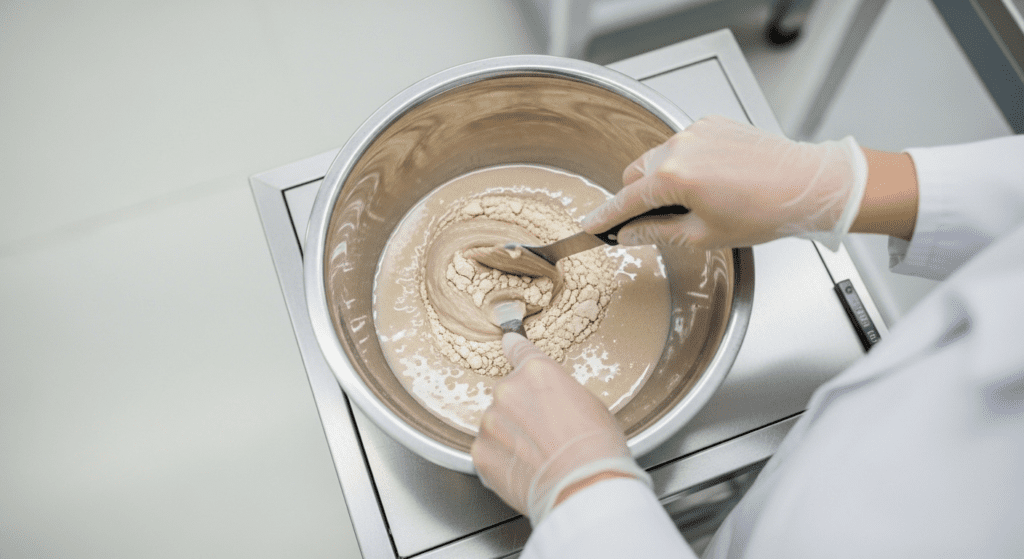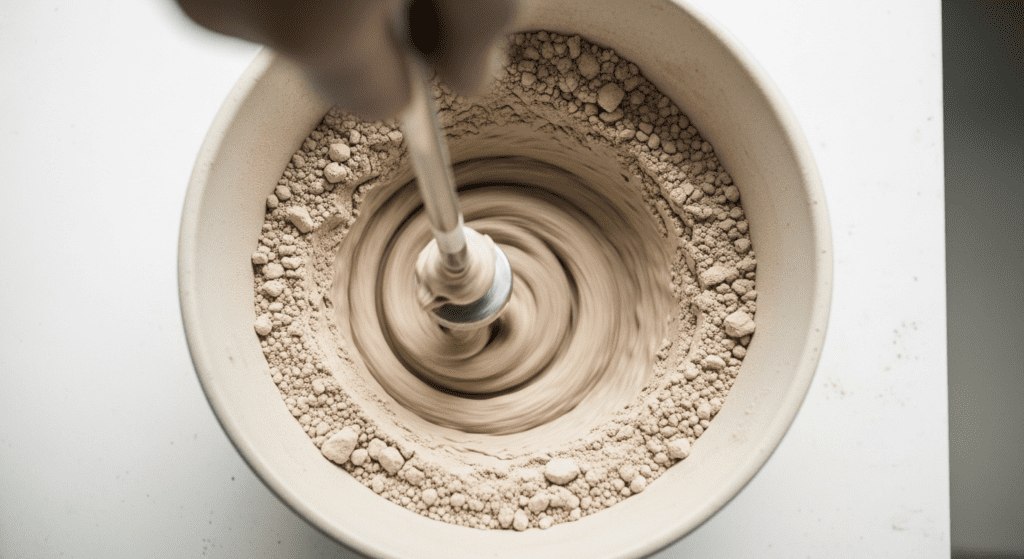Investment casting powder creates precise metal parts through a lost-wax process. The key is mixing refractory materials at the right ratios with water to form a ceramic shell around wax patterns. This shell withstands molten metal temperatures up to 3,000°F while capturing fine details down to 0.003 inches.
The most important factor is the mixing ratio for investment casting powder – typically 100 parts powder to 38-40 parts water by weight. Getting this ratio wrong ruins the entire casting.

Start with precise measurements of your dry components. Use a digital scale for accuracy.
The typical ratio is 25-30% gypsum to 70-75% silica flour. Measure each ingredient into separate containers before mixing.
Pass all dry ingredients through a fine mesh sieve. This removes lumps and ensures even distribution.
Mix the sifted materials thoroughly in a large container. Use a paint mixer attachment on a drill for best results.
Add your chosen modifiers to the dry mix. These might include boric acid, fibers, or colorants.
Blend for at least 3 minutes to ensure even distribution. Poor mixing leads to weak spots in your final mold.
The water-to-powder ratio is critical. Most investment powders need 38-42% water by weight.
Use distilled water at room temperature. Cold water slows setting, while warm water speeds it up.
Add powder to water, never the reverse. This prevents clumping.
Mix vigorously for 3-4 minutes. A mechanical mixer works best for consistent results. The mixture should flow like heavy cream.
Vacuum degassing is ideal, but you can also vibrate the container. Tap it repeatedly on a hard surface.
Continue for 60-90 seconds. Bubbles create surface defects in your castings.
Work quickly once mixed. Most investment powders set within 8-12 minutes.
Pour steadily to avoid trapping air. For detailed patterns, brush on the first coat before pouring.

The success of your investment casting depends on choosing the right materials. Each component serves a specific purpose in creating a strong, heat-resistant mold.
Silica makes up the bulk of investment powder, typically 70-75% by weight. It provides heat resistance and dimensional stability during metal pouring.
Common forms include cristobalite, quartz, and fused silica. Cristobalite offers the best thermal expansion properties for most jewelry casting.
Gypsum acts as the binder, holding the refractory particles together. It reacts with water to form a solid matrix.
Alpha-hemihydrate gypsum produces stronger molds than beta-hemihydrate but costs more.
Other refractory materials improve specific properties. Zircon adds strength and heat resistance for high-temperature alloys.
Alumina increases mold strength. Graphite helps with metal flow and mold breakdown after casting.
| Application | Silica/Refractory (%) | Binder (%) | Additives (%) | Example Composition |
|---|---|---|---|---|
| Jewelry/Small Parts (Ca-SO₄ systems) | 65–75% quartz and/or cristobalite | 25–35% α-hemihydrate gypsum | ~2–5% (borax/boric acid, surfactant, defoamer) | Example: 70% finely-ground silica (mixed quartz/cristobalite), 30% high-strength plaster of Paris, ~3% borax plus a wetting agent. Produces a hard, fine-mesh mold for low-melting alloys. |
| Resin or Dental Use | ~65% quartz/cristobalite | ~35% gypsum (often β-hemihydrate for smoother set) | ~5% (higher boric acid/borax to aid burnout) | Similar base mix to jewelry. Resin burnout molds often use slightly more boric acid (up to 5%) to protect the mold during the exothermic burnout of resin patterns. |
| Industrial High-Temp (MgO–P) | ~15% silica (fused quartz) | ~35% phosphate-modified gypsum (MgO + NH₄H₂PO₄) | ~5% boric acid; 45% zircon | Example: 45% zircon flour, 35% phosphate-bonded plaster, 15% fine silica, 5% boric acid. Used for aluminum or alloy castings above 1200°C. Zircon increases refractoriness and reduces thermal expansion. |
| Ceramic Shell (Colloidal SiO₂) | 100% refractory stucco (zircon/alumina) | Colloidal silica (as liquid binder) | — | Industrial multi-layer shells use colloidal silica or ethyl silicate (not a dry “powder”) plus dry stucco coat of zircon or alumina. Not typically made as a dry powder at home. |
